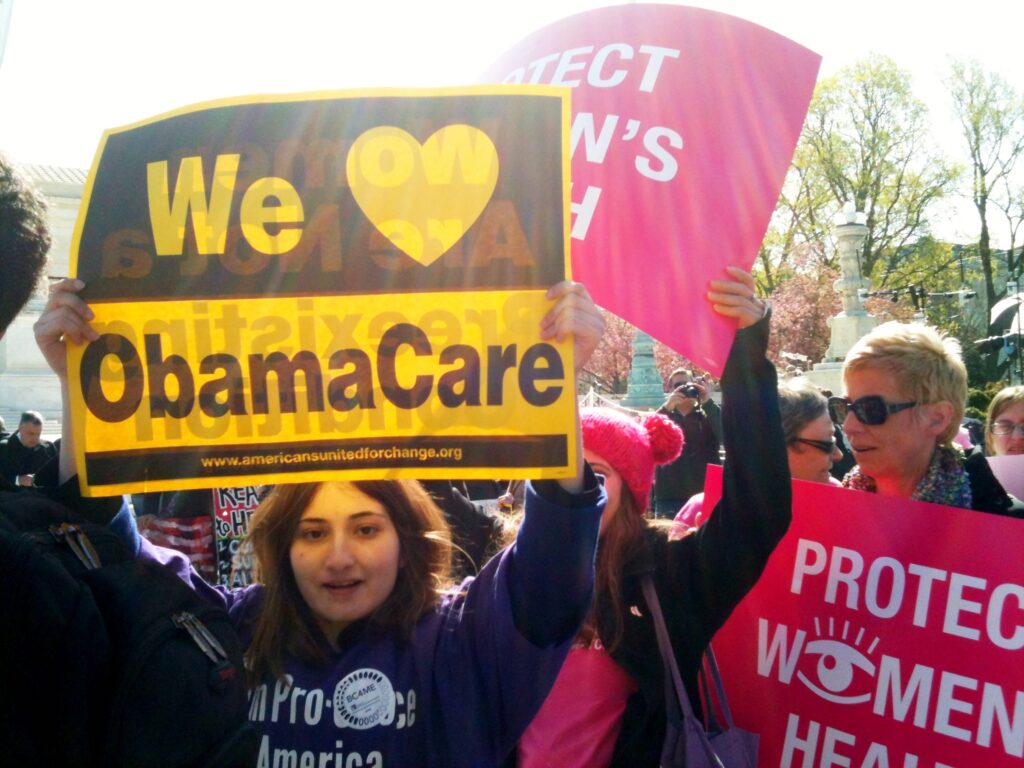Obamacare Coverage goes beyond just insuring the uninsured. It’s a multi-dimensional approach to healthcare reform that prioritizes prevention and wellness, enhances consumer protections, and aims to improve healthcare quality while curbing costs. From significant investments in health information technology and guidelines to reduce medical errors to a focus on improved care coordination, Obamacare Coverage embodies a comprehensive strategy for a healthier, more efficient, and more equitable healthcare system.
I. A Comprehensive Overview of Obamacare Coverage
The Affordable Care Act (ACA), formally known as the Patient Protection and Affordable Care Act and commonly referred to as Obamacare, stands as a monumental healthcare reform. Signed into law in March 2010 by then-President Barack Obama, its principal aim is to expand access to health insurance for uninsured Americans. In this section, we will provide a comprehensive overview of the ACA, shedding light on the key aspects of Obamacare Coverage.
Comprehensive Healthcare Reform Signed into Law in March 2010
The ACA was a groundbreaking legislative accomplishment when it was signed into law on March 23, 2010. It aimed to overhaul the American healthcare system, which was often criticized for its complexity and exclusivity. The law introduced a myriad of policies and provisions to make healthcare more accessible and affordable for millions of Americans, fundamentally altering the landscape of healthcare in the United States.
Also Known as the Patient Protection and Affordable Care Act or Obamacare
While the formal name of the law is the Patient Protection and Affordable Care Act, it’s more commonly known as Obamacare. This colloquial name became a catch-all term for the changes in healthcare policy and insurance provisions brought about by the ACA. Under Obamacare Coverage, several essential benefits became standardized, creating a baseline of care and protection for insured Americans.

Aim: Expand Access to Health Insurance for Uninsured Americans
The core objective of the ACA was to expand access to healthcare by making health insurance more affordable and inclusive. Before the ACA, millions of Americans were without health insurance, often because they couldn’t afford it or were denied coverage due to pre-existing conditions. The ACA aimed to bridge this gap by introducing several mechanisms:
- Health Insurance Marketplaces: These are platforms where individuals can compare and purchase insurance plans. Obamacare Coverage options are clearly laid out, helping consumers make informed choices.
- Medicaid Expansion: The ACA allowed states to expand Medicaid eligibility, thus covering a larger segment of low-income individuals and families.
- Subsidies and Tax Credits: To make insurance more affordable, the ACA included provisions for premium tax credits and cost-sharing reductions based on income.
- Consumer Protections: Obamacare Coverage also meant that insurance companies could no longer deny coverage based on pre-existing conditions. Additionally, it eliminated lifetime and annual coverage caps for essential health benefits.
- Young Adult Coverage: The ACA allows young adults to stay on their parents’ health insurance plans until the age of 26, providing a safety net for those transitioning into the workforce.
Obamacare Coverage: A Key Component of the ACA
The term “Obamacare Coverage” encompasses the range of benefits and protections offered by ACA-compliant health insurance plans. This includes essential health benefits like emergency services, maternity and newborn care, mental health services, and preventive and wellness checks, among others. Additionally, these services are often provided with no additional out-of-pocket costs, emphasizing the ACA’s focus on preventive care.
Financial Assistance Under ACA
One of the most impactful aspects of Obamacare Coverage is the financial assistance provided to low- and middle-income families. By offering premium tax credits and cost-sharing reductions, the ACA has made health insurance more financially accessible for millions.
State Involvement and Flexibility
The ACA provides states with the flexibility to expand Medicaid and establish their health insurance marketplaces. As of September 2022, 39 states and the District of Columbia had expanded Medicaid, bringing Obamacare Coverage to a wider demographic.
II. Understanding the Affordable Care Act (ACA)
The Affordable Care Act goes beyond merely providing insurance coverage. It has a multi-pronged approach aimed at transforming healthcare in America. Let’s delve deeper into how it reforms the health insurance industry, reduces costs, and the additional benefits it offers.

Reforms the Health Insurance Industry
The ACA radically changed the way the health insurance industry operates. One of its major reforms was prohibiting insurance companies from denying coverage based on pre-existing conditions. This made it possible for millions more Americans to get insured under Obamacare Coverage. Also, the ACA mandated a minimum set of “essential health benefits” that every insurance plan must offer, thereby standardizing healthcare benefits across the board.
Aims to Reduce the Cost of Health Insurance
Before the ACA, the cost of health insurance was a significant barrier to access for many individuals and families. The ACA sought to make healthcare more affordable in several ways. It implemented a system of subsidies and tax credits to help lower the financial burden for eligible individuals. Also, the creation of health insurance marketplaces introduced competition among providers, further driving down costs.
Includes Premium Tax Credits and Cost-Sharing Reductions
Financial accessibility is a cornerstone of the ACA. If you fall within a certain income bracket, you may be eligible for premium tax credits that reduce your monthly insurance payments. Cost-sharing reductions are another form of financial assistance provided by the ACA, aiming to lower the amount you have to pay for services like doctor visits and prescription drugs. This feature of Obamacare Coverage makes it more attainable for a broader section of the population.
Requires Preventive Services to be Covered at No Cost
The ACA took a proactive approach to healthcare by focusing on preventive services. ACA-compliant insurance plans are required to cover a range of preventive services at no additional cost to the policyholder. These services include immunizations, screenings for various health conditions, and patient counseling. The idea is to catch health issues before they become severe and costly to treat, thereby not only improving health outcomes but also reducing healthcare expenditures.
Enforces Coverage of “Essential Health Benefits”
One of the defining features of Obamacare Coverage is the enforcement of “essential health benefits”. These include services like emergency care, maternity and newborn care, mental health services, and prescription drugs. By standardizing these benefits, the ACA ensures that everyone has access to a baseline level of care, irrespective of the plan they choose.
III. State Participation in the Affordable Care Act
State participation plays a critical role in the success and reach of the Affordable Care Act (ACA), also popularly known as Obamacare. One of the pivotal aspects of this participation is the expansion of Medicaid to cover a broader spectrum of the population. As of September 2022, 39 states and the District of Columbia have chosen to expand Medicaid, thereby enlarging the scope of Obamacare Coverage. In this section, we will delve into the details of how state participation impacts Medicaid expansion and, by extension, Obamacare Coverage.
The Importance of State Participation
When the ACA was enacted in 2010, it was designed as a federal framework that allowed for state flexibility. This flexibility gives individual states the option to tailor the program to better suit their specific healthcare needs. The most significant example of this flexibility lies in the expansion of Medicaid, a move that has significantly widened the availability of Obamacare Coverage.
Medicaid Expansion: A Key Element of Obamacare
Medicaid is a joint federal and state program that provides healthcare coverage to low-income individuals and families. The ACA aimed to expand this coverage by raising the income eligibility criteria, allowing more people to qualify for Medicaid and, by extension, Obamacare Coverage. Initially, the ACA required all states to expand Medicaid, but a Supreme Court ruling in 2012 made this optional for states.
States Embracing Medicaid Expansion
As of September 2022, 39 states and the District of Columbia have embraced Medicaid expansion. This is a significant increase from the early years of the ACA and shows growing state-level support for the program. By opting into Medicaid expansion, these states have extended Obamacare Coverage to include many individuals who would otherwise fall through the cracks.
The Impact on Obamacare Coverage
With the expansion of Medicaid, the umbrella of Obamacare Coverage has also widened. Those who were previously ineligible for Medicaid due to income limitations can now take advantage of this broader coverage. For instance, in states that have expanded Medicaid, adults with incomes up to 138% of the federal poverty level are now eligible for coverage. This means more people have access to essential healthcare services like preventive screenings, mental health support, and emergency care.
Financial Incentives for States
States that opt for Medicaid expansion receive financial incentives from the federal government, making it economically advantageous to extend healthcare coverage. For the initial years of the expansion, the federal government covered 100% of the cost. This percentage has slightly reduced but remains high, providing a compelling financial case for states to expand Obamacare Coverage via Medicaid.
States Yet to Expand Medicaid
While 39 states and the District of Columbia have expanded Medicaid, 11 states have yet to adopt this aspect of the ACA. In these states, many low-income adults still find themselves in a “coverage gap,” earning too much to qualify for traditional Medicaid but too little to afford private insurance. This gap represents a significant challenge in extending Obamacare Coverage to all Americans.
The Ripple Effects of State Participation
The states that have chosen to expand Medicaid have seen a ripple effect of benefits. Beyond the obvious health advantages for those gaining coverage, there is also a broader societal impact. Expanded healthcare access reduces the strain on emergency services, lowers the cost of healthcare overall, and contributes to a healthier, more productive workforce.
IV. Key Features of the Affordable Care Act
1. Expand Access to Insurance
The Affordable Care Act (ACA), often referred to as Obamacare, has been a transformative piece of legislation in the American healthcare landscape. One of its core objectives is to expand access to insurance for the uninsured and underinsured population. In this section, we’ll explore the key features that contribute to this objective, including employer coverage requirements, tax credits for small businesses, insurance exchanges, Medicaid expansion, and extended coverage for young adults up to age 26.
Employer Coverage Requirements
One of the first pillars of the ACA is the mandate for medium and large employers to provide health insurance to their employees. Known as the Employer Mandate, this requirement ensures that companies with 50 or more full-time employees offer affordable and minimum essential health coverage. This feature significantly expands access to insurance by making it a standard employment benefit.
Tax Credits for Small Businesses
To incentivize small businesses to offer health coverage, the ACA introduced Small Business Health Care Tax Credits. Companies with fewer than 25 full-time employees that pay average annual wages below $50,000 can qualify for these tax credits. By offsetting the cost of providing insurance, this feature encourages more small businesses to offer coverage, thereby widening the insurance net.
Created Insurance Exchanges
One of the most visible features of the ACA is the creation of Health Insurance Marketplaces, or Exchanges. These platforms serve as one-stop shops where individuals can compare and purchase insurance plans. The exchanges bring transparency and competition to the health insurance industry, making it easier and often more affordable for people to purchase plans.
Medicaid Expansion
Arguably one of the most impactful features of the ACA is the expansion of Medicaid eligibility. This feature allows states to extend Medicaid to individuals with incomes up to 138% of the federal poverty level. As of now, 39 states and the District of Columbia have expanded Medicaid, providing millions of low-income Americans with access to essential healthcare services.
Coverage for Young Adults Until Age 26
Last but not least, the ACA allows young adults to remain on their parents’ insurance plans until the age of 26. This provision has been especially beneficial for college students and young adults entering the workforce, offering them a safety net as they transition into full independence.
2. Enhancing Consumer Insurance Protections
This section aims to shed light on how Obamacare Coverage has enhanced insurance security by prohibiting lifetime and annual monetary caps, enabling state rate reviews for premium increases, and offering protection for children with preexisting conditions.

Prohibits Lifetime and Annual Monetary Caps
One of the groundbreaking features of Obamacare Coverage is the prohibition of lifetime and annual monetary caps on essential health benefits. Before the ACA, many people faced financial ruin when their healthcare costs exceeded these caps, particularly in the case of chronic illnesses or severe accidents. By eliminating these caps, Obamacare has ensured that individuals don’t have to choose between financial stability and essential medical treatments.
State Rate Reviews for Premium Increases
Health insurance is a significant expense for most families, and unexpected rate hikes can be devastating. Under the ACA, insurance companies are required to justify any significant rate increases to the state, usually any hike greater than 10%. States are empowered to review these justifications to ensure they are reasonable. This state rate review process adds a layer of accountability to the insurance industry, making Obamacare Coverage not just comprehensive but also financially transparent.
Protection for Children with Preexisting Conditions
Among the most heartening features of Obamacare is the protection it offers to children with preexisting conditions. Before the ACA, it was common for insurance companies to refuse coverage for minors with medical conditions like asthma, diabetes, or congenital anomalies. Obamacare Coverage has changed this landscape entirely. Now, no child can be denied insurance coverage based on a preexisting condition, offering peace of mind to countless families and leveling the playing field for the next generation.
The Collective Impact
The collective impact of these consumer protections is monumental. By removing lifetime and annual limits, Obamacare Coverage ensures that healthcare is accessible over the long term, even for those who experience severe or chronic health issues. The state rate review mechanism offers an additional layer of financial security, making healthcare costs more predictable and manageable. Finally, by safeguarding insurance for children with preexisting conditions, Obamacare takes a significant step toward healthcare equality.
3. Prevention and Wellness
Prevention and Public Health Fund
One of the landmark features of Obamacare is the establishment of the Prevention and Public Health Fund. This is the nation’s first mandatory funding stream aimed at improving public health. The fund allocates billions of dollars to support a wide range of public health activities, including community and clinical prevention initiatives. By dedicating financial resources to prevention, Obamacare Coverage aims to reduce the long-term costs of healthcare in America.
National Prevention, Health Promotion, and Public Health Council
Another pivotal component of the ACA’s preventive focus is the National Prevention, Health Promotion, and Public Health Council. Comprised of leaders from various federal departments, the Council is responsible for providing coordination and leadership at the federal level concerning prevention, wellness, and health promotion practices. This council plays a vital role in shaping Obamacare Coverage by recommending policies that emphasize preventive care over reactive treatments.
Required Coverage for Preventive Care
Perhaps the most direct impact of the ACA on individual healthcare is its requirement for insurance plans to cover a range of preventive services at no additional cost. This mandatory provision includes various screenings, vaccinations, and counseling services. By making these services easily accessible, Obamacare Coverage encourages early detection and management of health conditions, thereby saving costs and improving health outcomes in the long run.
The Holistic Impact
The ACA’s emphasis on prevention and wellness takes a holistic approach to healthcare. Instead of merely treating diseases as they occur, Obamacare Coverage aims to equip individuals with the tools and knowledge to prevent illnesses. This not only improves quality of life but also has a significant impact on healthcare expenditures. Preventive healthcare is often more cost-effective than treatment, making it a financially prudent focus for public health policy.
4. Improve Health Quality and Curb Costs
Investment in Health Information Technology
The integration of technology into healthcare has the potential to revolutionize patient outcomes and bring down costs. Obamacare Coverage includes provisions for significant investment in health information technology (IT). This investment aims to streamline healthcare delivery and management. Digital health records, telemedicine, and data analytics are some of the areas that benefit from this focus. The objective is to create a more efficient, responsive, and personalized healthcare system, ultimately reducing operational costs and improving patient care.

Guidelines to Reduce Medical Errors
Medical errors not only jeopardize patient safety but also contribute to the ballooning costs of healthcare. Recognizing this, the ACA has put forth specific guidelines aimed at reducing medical errors. These range from standardized procedures for surgeries to protocols for medication administration. By implementing these guidelines, healthcare providers under Obamacare Coverage are expected to minimize risks and improve patient outcomes, leading to fewer malpractice claims and lower overall costs.
Improved Care Coordination
One of the challenges in healthcare is the lack of effective coordination among various providers, which often results in redundant tests and disjointed care. The ACA addresses this by promoting improved care coordination. Various incentives and programs under Obamacare Coverage encourage healthcare providers to collaborate, share information, and plan treatment more efficiently. Integrated care models, such as Accountable Care Organizations (ACOs), are a direct result of this focus. Better coordination not only elevates the quality of care but also eliminates unnecessary expenditures, making healthcare more affordable for both the system and the patients.
The Combined Impact
When examined collectively, these strategies form a comprehensive approach to healthcare reform. By investing in health IT, the ACA equips healthcare providers with the tools to offer more accurate and timely care. The guidelines to reduce medical errors add a layer of safety and reliability. Improved care coordination ensures that the healthcare journey is not just effective but also seamless and less costly.
Summary
In summary, Obamacare Coverage is not just an insurance policy; it’s a healthcare revolution. It focuses on giving you comprehensive preventive care, safeguards against unfair practices, and utilizes cutting-edge technology to improve healthcare quality—all while keeping an eye on costs. At TMT Insurance, we offer tailored Obamacare plans that capitalize on each of these advantages, providing you with a healthcare experience that is both superior and cost-effective. If you’re interested in a holistic approach to your health and well-being, it’s time to explore what Obamacare through TMT Insurance can do for you.











